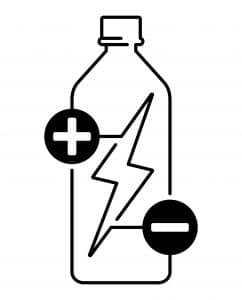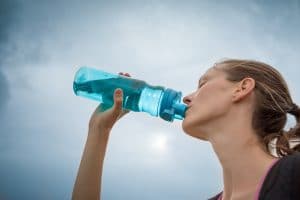
26 Oct How To Replenish Electrolytes: Tips And Tricks
Simply put, electrolytes are essential for your body to function. When one or more electrolytes become too low or too high, an imbalance occurs, which can result in anything from minor symptoms to major long-term health concerns.
Some medical conditions can alter the balance of electrolytes and your needs may vary, so it’s important to check with your healthcare provider if you have any questions or concerns about your electrolyte levels. Here are some tips and tricks to help learn how to replenish electrolytes in a safe manner.
What Are Electrolytes?

Electrolytes are minerals, such as sodium, calcium, magnesium, and potassium, that are necessary for a variety of bodily functions. Electrolytes are minerals that have an electrical charge. They’re essential for health and survival.
The Benefits Of Electrolytes
Electrolytes spark cell function throughout your body. They also support hydration and assist the body to produce energy. So what are the other benefits of electrolytes?
• Regulate the fluid levels in your blood plasma and your body
• Keep the pH (acid/alkaline) of your blood in the normal range (7.35-7.45)
• Enable muscle contractions, including the beating of your heart
• Transmit nerve signals from heart, muscle, and nerve cells to other cells
• Help blood to clot
• Help build new tissues
The good news: generally healthy individuals shouldn’t need to be too concerned about major electrolyte imbalances, however, it is important to maintain adequate hydration to maintain this balance.
The Importance Of Electrolytes For Your Overall Health
Clearly, electrolytes are essential for your body to function. Electrolytes are also responsible for stimulating muscle contractions. This includes the muscles that keep your heart beating. When one or more electrolytes become too low or too high, an imbalance occurs, which can result in anything from minor symptoms to major long-term health concerns.
For example, a calcium deficiency can weaken a person’s bones over time and may lead to osteoporosis. High calcium levels, on the other hand, might cause kidney failure, arrhythmia (abnormal heart rhythm), mental confusion, and even coma. 
How Many Electrolytes Are Required Daily?
The amount of electrolytes you need on a daily basis varies and depends on several factors including:
- Age
- Level of activity
- Amount of water consumed
- Climate
Most people get enough electrolytes from the foods and beverages they consume every day. In some cases, electrolyte beverages like sports drinks may be a good method for replacing electrolytes that were lost during extreme activity.
Electrolytes exit the body through urine and sweat. For that reason, if you exercise in hot weather and sweat a lot, or work out strenuously for more than an hour or two, drinking electrolyte beverages before, during, and after your workout may be a benefit for you. Likewise, other people at risk for dehydration, such as those with a high fever, diarrhea, and vomiting may also need electrolyte beverages such as Gatorade G2 with no sugar added.
What Causes An Electrolyte Imbalance?
Electrolyte imbalances can be the result of various factors such as:
- Losing fluids due to persistent diarrhea, vomiting, sweating, or fever
- Not eating or drinking enough
- Emphysema or other chronic respiratory problems such as Chronic Obstructive Pulmonary Disease (COPD)
- Metabolic alkalosis: A higher than normal blood PH level
- Taking medications such as steroids, diuretics, and laxatives
To make sure you have enough electrolytes, stay hydrated and eat the foods mentioned earlier that are rich in electrolytes.
What Are Some Signs Of An Electrolyte Imbalance?
Electrolytes must exist within the body within certain ranges. If the levels become too high or too low, an electrolyte imbalance can happen.
If you find out that you need to replenish your electrolyte levels, you can incorporate electrolyte-rich foods into your diet. Here’s a list of the most common electrolytes and foods that contain them:
- Calcium: Milk and milk products (including plain, nonfat yogurt), meat, fish with bones (e.g., sardines), eggs, fortified breakfast cereals, beans, certain fruits and vegetables (e.g., asparagus, collard greens, dried apricots, and figs)
- Magnesium: Leafy green vegetables (e.g., spinach, turnip greens, collard greens, kale), whole grains, nuts, peanut butter, dried beans, and lentils
- Potassium: Spinach, sweet potato, plain nonfat yogurt, bananas, avocado, peas, beans, tomatoes, oranges, melons, prunes, and raisins
- Sodium: While we don’t want to overdo it on sodium, it is crucial for maintaining fluid balance. The general recommendation is that most healthy individuals should stay below 2300mg per day while those at risk for heart disease or that have high blood pressure should stay below 1500mg per day.
Sodium: (Normal range 135-145)
Except for sodium, you probably won’t get too many electrolytes in your diet. A high sodium level and common electrolyte problem called hypernatremia, causes water to move out of your cells. On the other hand, low sodium levels called hyponatremia, causes water to accumulate in the cells. If either of these things happens in brain cells, it may cause the following complications:
- Personality changes
- Headache
- Confusion
- Lethargy
If the drop in sodium is extreme it can cause:
- Seizures
- Coma
- Death
Chloride: (Normal range 96-106)
A low chloride level, called hypochloremia, can be caused by:
- Excessive vomiting
- Stomach content suctioning
- Diuretic medications used to treat fluid retention
High chloride (hyperchloremia) frequently comes from diarrhea or kidney disease.
Potassium: (Normal range 3.5-5.5)
Low potassium is called hypokalemia and might not cause any symptoms. However, it can affect how your body stores glycogen, the source of energy stored for our muscles.
A low level of potassium, below 3, can cause:
- Muscle weakness
- Spasms
- Cramps
- Paralysis
- Respiratory problems
High potassium (hyperkalemia) also might not cause any symptoms but you might experience:
- Muscle weakness
- Abnormal heart rhythms
If it isn’t corrected, very high levels of potassium can cause kidney problems, abnormal heart rhythms, or the heart to stop beating altogether.
Calcium: (Normal range 8.5-10.2)
Hypocalcemia, low calcium, also might not cause symptoms, but chronically low calcium levels can cause:
- Changes in nails, skin, and hair
- Yeast infections
- Cataracts
- Cramps, especially in the legs and back
Calcium levels under 7 cause the following symptoms:
- Hyperreflexia (changes in your reflexes)
- Muscle spasms
- Spasms in the voicebox (larynx)
- Seizures
High calcium (hypercalcemia) might not cause symptoms, but as calcium rises these symptoms may occur:
- Loss of appetite
- Constipation
- Nausea and vomiting
- Pain in the abdomen
- Bowel obstruction
Continuous or severe hypercalcemia can damage kidneys and cause heart problems.
Magnesium: (Normal range 1.7-2.2)
Low magnesium (hypomagnesemia) might cause symptoms that are similar to low calcium or potassium. Extremely low levels can be life-threatening. High magnesium (hypermagnesemia) may result in:
- Low blood pressure
- Problems like slow, ineffective breathing
- Loss of heart function (cardiac arrest)
Phosphate/Phosphorus: (Normal range 2.5-4.5)
Hypophosphatemia (low phosphate) can cause:
- Muscle weakness
- Respiratory failure
- Heart failure
- Seizures
- Coma
Low phosphorus can be caused by:
- Poor nutrition
- Some diuretic medications
- Diabetic ketoacidosis (A complication of diabetes)
- Alcoholism
- Severe burns
High phosphates (hyperphosphatemia) may not cause symptoms. It may be caused by:
- Tumor lysis syndrome
- Infection
- Chronic kidney disease
- Parathyroid gland disorder
- Acidosis (blood more acidic than normal)
How To Replenish Electrolytes: Tips And Tricks
There are many ways that you can replenish your electrolytes including:
- Drinking unsweetened coconut water. Coconut water is a good source of electrolytes.
- Eating bananas (A good source of the vitamin potassium)
- Consume dairy products
- Cook white meat and poultry
- Eat avocados
- Drink fruit juices, but with not too much sugar added
- Snack on fruits such as watermelon
- Try electrolyte-infused waters
When Do Salt Tablets Help Balance The Body?
Your body is at its healthiest when the water-sodium balance is right. Usually, drinking enough water and eating a healthy diet is good enough to keep everything working correctly while you go about your life. However, salt tablets do help in certain situations such as:
Sweating Heavily
In extreme situations like working for hours in high temperatures or competing in a marathon, you may lose unhealthy amounts of sodium, water, and other electrolytes your body needs.
When Electrolyte And Fluid Levels Are Low
If both fluid and sodium levels have seriously dropped, drinking water isn’t enough. Your body won’t keep a healthy fluid level without sodium and other electrolytes. Therefore the water you drink will be lost quickly.
When Staying Hydrated By Drinking A lot Of Water And Other Fluids
Keep in mind that every cell in your body and every function needs fluids to stay healthy. Taking salt tablets without drinking lots of fluids can bring about an unhealthy buildup of sodium. This forces your kidneys to eliminate more of the sodium in sweat and urine without making you feel hydrated. When taken with water, salt tablets can help distance runners and other individuals who are at high risk for dehydration and heat cramps. 
In a study from 2015, it was found that salt tablets helped improve the concentrations of electrolytes in the bloodstream and reduced water-weight loss during a half-Ironman race. Weight loss that’s made of mostly water after an endurance race doesn’t last.
Even temporarily losing too much water can have a bad effect on organ function. Even though they can be bought over-the-counter without a prescription, it’s best to use salt supplements with a doctor’s supervision.
When Should You Be Concerned About Your Electrolyte Levels?
The good news: generally healthy individuals shouldn’t need to be too concerned about major electrolyte imbalances. If you do feel that there may be a problem, consult with your medical professional to ensure everything is functioning optimally. It’s important to maintain adequate hydration to maintain this balance.
How To Replenish Electrolytes With FITTEAM Global
So how can you get electrolytes from your diet to avoid these severe electrolyte spikes or dips? One key way is to enjoy FITTEAM HYDRATE daily. It is an easy and delicious way to get in those electrolytes you need year-round, but especially on warmer days as well as days when you are more active. Contact us now and be at your best soon.
References:
www.roswellpark.org/cancertalk/201808/electrolytes-what-are-they-what-happens-if-you-dont-have-e

